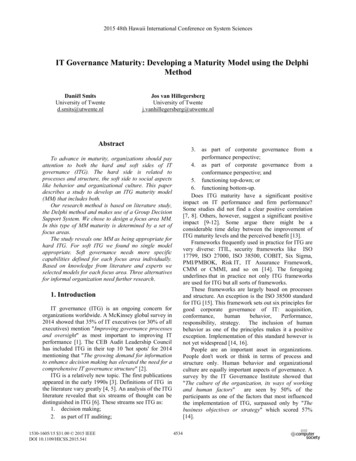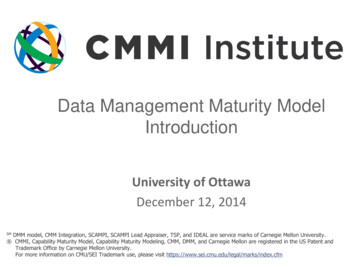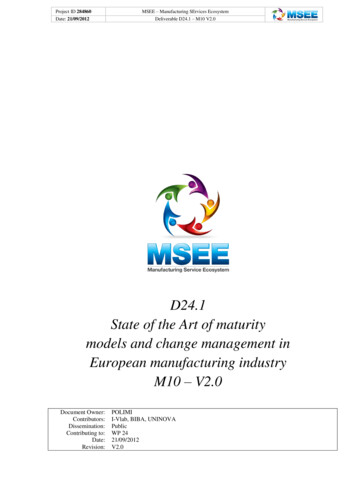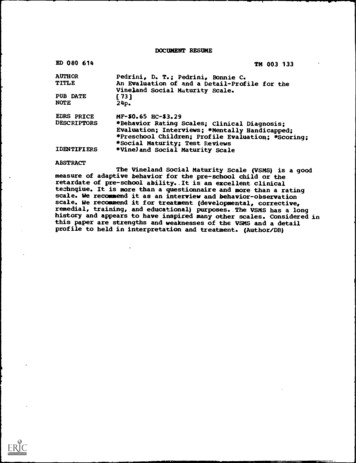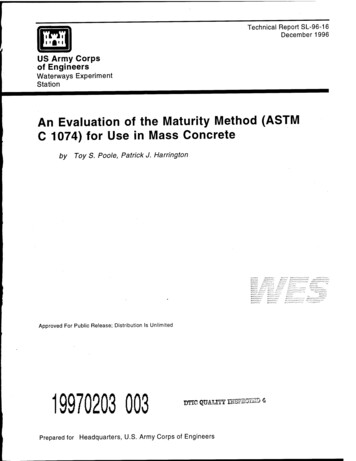
Transcription
miTechnical Report SL-96-16December 1996US Army CorpsDf Engineers 1Waterways ExperimentStationAn Evaluation of the Maturity Method (ASTMC 1074) for Use in Mass ConcretebyToy S. Poole, Patrick J. HarringtonApproved For Public Release; Distribution Is Unlimited19970203 003OTIC QUALITY HTBPSOi'iäS &Prepared for Headquarters, U.S. Army Corps of Engineers
The contents of this report are not to be used for advertising,publication, or promotional purposes. Citation of trade namesdoes not constitute an official endorsement or approval of the useof such commercial products. PRINTED ON RECYCLED PAPER
Technical Report SL-96-16December 1996An Evaluation of the Maturity Method (ASTMC 1074) for Use in Mass Concreteby Toy S. Poole, Patrick J. HarringtonU.S. Army Corps of EngineersWaterways Experiment Station3909 Halls Ferry RoadVicksburg, MS 39180-6199Final reportApproved for public release; distribution is unlimitedPrepared forU.S. Army Corps of EngineersWashington, DC 20314-1000
US Army Corpsof EngineersWaterways ExperimentStationHBUXUMTB6HUM(TON CONTACT:PUBLIC AFFAIRS OFFICEU. S. ARMY ENGINEERWATERWAYS EXPERMENT STATION »HAUS FERRY ROAD«CKSBUnO, MBSBWl »1M41MPHONE: (Hn)t34-2902Waterways Experiment Station Cataloging-in-Publication DataPoole, Toy S. (Toy Spotswood), 1946An evaluation of the maturity method (ASTM C 1074) for use in mass concrete / by ToyS. Poole, Patrick J. Harrington ; prepared for U.S. Army Corps of Engineers.33 p.: ill.; 28 cm. — (Technical report; SL-96-16)Includes bibliographic references.1. Concrete — Mixing. 2. Concrete — Specifications. I. United States. Army. Corps ofEngineers. II. U.S. Army Engineer Waterways Experiment Station. III. StructuresLaboratory (U.S. Army Engineer Waterways Experiment Station) IV. Title. V. Series:Technical report (U.S. Army Engineer Waterways Experiment Station); SL:96-16.TA7W34no.SL-96-16
ContentsPreface1—IntroductionBackgroundThe Maturity Method2— Materials and MethodsMaterials and Concrete Mixture PropertiesCalibration SpecimensTemperature and Strength Measurements of In-Place Concrete3—Results and DiscussionEmpirical Determination Q and Datum TemperatureTime-Temperature HistoryMaturity CalculationsPredicted vs Observed Strengthiv1114455668994—Conclusions and Recommendations13References14Figures 1-14in
PrefaceThe investigation described in this report was conducted by the Concrete andMaterials Division (CMD), Structures Laboratory (SL), U.S. Army EngineerWaterways Experiment Station (WES). The work was sponsored byHeadquarters, U.S. Army Corps of Engineers, as part of Civil WorksInvestigation Studies Work Unit 31138, "New Technologies for Testing andEvaluating Concrete."The study was conducted under the general supervision of Messrs. BryantMather, Director, SL, and John Q. Ehrgott, Assistant Director, SL. Dr. Paul F.Mlakar was Chief, CMD, during this work. Direct supervision was provided byMr. Edward F. O'Neil, Acting Chief, Engineering Mechanics Branch (EMB),CMD. MAJ Patrick J. Harrington was the principal investigator during theplanning and data-collection phases of the work. Messrs. Anthony A. Bombichand Richard Haskins, EMB, designed and supervised the placement ofinstrumentation and automatic data collection. MAJ Harrington performed mostof the maturity calculations, and Dr. Toy S. Poole analyzed the data and wrote thereport.At the time of the publication of this report, Director of WES wasDr. Robert W. Whalin. Commander was COL Bruce K. Howard, EN.The contents of this report are not to be used for advertising, publication,or promotional purposes. Citation of trade names does not constitute anofficial endorsement or approval of the use of such commercial products.IV
1IntroductionBackgroundThe objective of this work was to investigate the applicability of AmericanSociety for Testing and Materials (ASTM) C 1074,1 "Standard Practice forEstimating Concrete Strength by the Maturity Method" (ASTM 1992h), to theestimation of in-place strength of mass concrete containing large amounts of flyash. To accomplish this, the U.S. Army Engineer Waterways ExperimentStation (WES) and U.S. Army Engineer District, Vicksburg, cooperated in aninvestigation involving concrete construction at Red River Waterway Lock andDam No. 4 (L&D 4). This investigation included laboratory determination ofmaturity parameters of the concrete mixture used at L&D 4, then comparedstrengths predicted from maturity measurements with strengths measured on corestaken from two monoliths that had been instrumented for temperaturemeasurements.The Maturity MethodEven though strength development in lab concrete is usually determined withtime as the single independent variable; i.e., temperature is held constant, it iswell known that strength development of in-place concrete is dependent on bothtime and temperature. The summation of the time-temperature history ofconcrete determines its maturity. Because time-temperature history of in-placeconcrete can differ considerably from the time-temperature history of similarlaboratory-cured specimens, strength development of the laboratory-curedspecimens is often a poor indicator of strength development of the in-placeconcrete. Field curing of specimens is an established practice (e.g., ASTM C 31(ASTM 1992a), ASTM C 873 (ASTM 1992g)) that seeks to reduce thisdiscrepancy and these methods provide a reasonable solution to this problem whenthe dimensions of the concrete structure are such that ambient temperature is theprincipal factor controlling the temperature of both the in-place concrete and the1This work was done prior to 15 Sep 93 and used C 1074-87, which was replaced on 15 Sep93 by C 1074-93, which was revised in Aug 95 to correct Equation 2.Chapter 1Introduction
test specimens. In the case of mass concrete, the ambient temperature is only oneof several factors controlling concrete temperature, with size of placement, rate ofheat evolution, and location in the placement being others. Therefore, the timetemperature history of mass concrete, and consequently the strength development,may vary considerably from that of field-cured specimens and may varythroughout the structure. This complexity makes use of laboratory-cured or fieldcured specimens essentially useless in predicting in-place strength. However, iftemperature history can be determined and a reasonable functional relationshipbetween strength and this time-temperature history can be developed, thenstrength development can be estimated from this temperature history. There hasbeen and continues to be considerable research on the mathematical relationshipsappropriate for this purpose (Kjellsen and Detwiler 1993; Carino and Tank 1992;Chengju 1989; Carino, Knab, and Clifton 1992; Carino 1984). Malhotra andCarino (1991) provides a good description of much of this. ASTM C 1074(ASTM 1992h) is a practice that uses two of these approaches.Literature on the application of maturity concepts to prediction of strength ofconcrete date to the late 1940's (Chengju 1989; Oluokun, Burdette, andDeatherage 1990). In these early efforts, maturity was represented as the simplesum of the number of degree-days above 0 C, the minimum temperature at whichcement was believed to hydrate. The method was calibrated by measuring thestrength of laboratory concrete specimens whose time-temperature history wasknown. This approach, with some modifications, was useful as long as concretetemperatures did not exceed about 30 C. Beginning in the 1960's, efforts weremade to relate the effect of time-temperature history to more sophisticatedthermodynamic principles. ASTM C 1074 (ASTM 1992h) includes proceduresrepresenting both of these approaches.Representing the older, simpler approach, ASTM C 1074 uses the followingmaturity function:M(t) (T, -T0)At(1)whereM(t) time-temperature factor at time tTa average concrete temperature over a time interval (At)T„ datum temperatureDatum temperature is a constant that is determined for each concrete andrepresents the minimum temperature at which cement hydrates. In the absence ofan empirically determined value, the method recommends using 0 C. By use of aset of calibration specimens, the time-temperature factor is related to strengthdevelopment. From this calibration curve, strengths can be predicted for a giventime-temperature factor of in-place concrete.In the other approach described in ASTM C 1074 (ASTM 1992h), anequivalent age (O is calculated:Chapter 1Introduction
-Qte AfeL - TT(2)This work was done prior to 15 Sep 1993 and used ASTM C 1074-87, which wasreplaced on 15 Sep 1993 by ASTM C 1074-93, which was revised in Aug 1995 tocorrect Equation 2whereAtT„T0Q time interval between temperature readingsaverage temperature over the intervalreference temperatureconstant specific to each concreteThe reference temperature can be any value, but the same value is usedthroughout all calculations. A calibration curve is prepared from strengths ofspecimens whose time-temperature history is known. Then from timetemperature data taken from in-place concrete, strength can be estimated from thiscalibration curve.The principle underlying this procedure is that the dependence of rate ofstrength gain on temperature follows the Arrhenius equation:k - Ae" (3)wherekE,RTA rate constant of the strength versus time relationshipactivation energygas constanttemperature ( K)frequency factor and does not enter into the maturity calculationsASTM C 1074 simplifies this equation by defining a parameter, Q, which is equalto E./R. The method gives procedures for determining Q empirically, or, in theabsence of such determinations, default values are recommended.In this work, calculations were done with both approaches, on laboratoryprepared and cured specimens, and on two concrete monoliths that had beeninstrumented for temperature measurements. Cores were then taken fromlocations near the temperature sensors to determine how well predicted strengthsconformed to actual strength in these monoliths.Chapter 1Introduction
2Materials and MethodsMaterials and Concrete Mixture PropertiesConcrete was made from Type II portland cement that had been specified tomeet the heat-of-hydration requirement of ASTM C 150 (ASTM 1992c)(290 kj/kg at 7 days). This cement has lower C3A and C3S contents thancommonly available Type II cements and is ground to a coarser particle size.These properties are necessary to meet the heat-of-hydration requirement.Properties of a sample of this cement used in the laboratory-prepared calibrationspecimens are described in Table 1. Fly ash met requirements of a Class Cpozzolan (ASTM C 618 (ASTM 1992f)). Properties of a sample used in thelaboratory determinations are also described in Table 1. The concrete mixtureused to make the laboratory specimens is described in Table 2. This mixture wasthe same as that used in the monolith construction.Table 1Chemical and Physical Properties of Portland Cement and Fly AshChemicalAnalysisPortlandCementFly AshSi02, %21.235.1Fineness, AP, m2/kg290Al203, %5.019.0Initial Set, min190340Fe203, %6.51 Physical Property8.5Final Set, minCaO, %61.6-Air, %MgO, %0.94.93-day Str., MPaPortlandCement911.8S03, %2.62.37-day Str., MPa16.9LOI. %0.80.3Heat of Hydr.kj/kg, 7 days259Insol. Res., %0.11Fineness, %Na20, %0.10-K20, %0.46C3A. %3C3S, %37C2S, %33C4AF, %20Density, Mg/m3Str. Index, %, 7 dayWater Req, %Soundness, %-0.01Fly Ash 182.5585940.001Chapter 2Materials and Methods
Calibration SpecimensTwenty-four 152- x 305-mm cylinders were cast for compressive strengthdeterminations and two similar cylinders were cast with embedded temperaturesensors in their center. The specimens were cured in a moist room meeting therequirements of ASTM C 511 (ASTM 1992e). Compressive strengths weredetermined at 1, 3, 7, 14, 27, 56, and 90 days according to ASTM C 39 (ASTM1992b).Table 2Mixture Proportions for Laboratory Concrete, Mixture No. B4ComponentSSD Mass or vol/m*Portland Cement162kg71kgFine Aggregate711kgCoarse Aggregate637kgCoarse Aggregate642kgAir-Entraining Admixture104mLWater125kgFly AshTemperature and Strength Measurements ofIn-Place ConcreteTwo placements were instrumented with thermocouples to measure timetemperature history. These were in monoliths 6/7 (ML6/7), placed on16 March 93, and monoliths 14 and 15 (ML14/15), placed on 16 August 93. Thepositioning of thermocouples is illustrated in Figures la and lb. Cores were takennear the thermocouples at 4, 7, 14, 28, and 52 days after placing for ML6/7 andat 4, 7, 14, 28, and 44 days after placing for ML14/15. Cores were cut into 102x 203-mm cylindrical specimens and compressive strength determined accordingto ASTM C 39 (ASTM 1992b). The mean strength of three cores was taken as avalue for each age.Eight thermocouples were placed in each monolith, as illustrated in Figure 1.A Quadrel Calorimeter data logger was used to accumulate time-temperature datafrom four of them (no. 2, 4, 6, and 8). Temperature of the concrete was taken asthe average of the four measurements. Data were logged every 0.25 hr frominitial concrete placement through 14 days, then every 0.5 hr through the end ofthe test. Data from ML6/7 were collected through 52 days and data fromML14/15 through 44 days. Temperature data for laboratory-cured specimensused for calibration were collected every 0.25 hr through 12 days, then every0.5 hr through 36 days, then every 100 hours through 91 days.Chapter 2 Materials and Methods
3Results and DiscussionEmpirical Determination Q and Datum TemperatureQ and datum temperature (DT) were determined empirically for both a mortarcontaining fly ash and a mortar containing no fly ash, using strength developmentof mortar cubes, as directed in ASTM C 1074 (ASTM 1992h). The no-fly ashcondition was not pertinent to this work but was included so that values of Qdetermined could be compared to literature values as a plausibility check. Curingtemperatures were 10, 23, and 38 C. Fly ash mortar batches contained 325 g ofcement, 146 g of fly ash, 1,460 g of project sand, and a water to cement plus flyash ratio (w/c fa) of 0.54 by mass. Portland cement mortar batches contained500 g of cement, 1,550 g of sand, and a w/c of 0.54. Materials werepreconditioned at their respective temperatures prior to mixing and kept at thosetemperatures until time of strength testing. Time of setting (ASTM C 191 (ASTM1992d)) was determined at each temperature and was used as the basis fordetermining ages at which strength would be determined (para Al. 1 of C 1074(ASTM 1992h)). Three mortar cubes were broken at each age. Mean strengthsare summarized in Table 3.Table 3Mortar-Strength Data Used in Calculating QAqe is in Days, Strength (str) is in MPa0% fly ash10 *CTOS 9hr0% fly ash23 *CTOS 6hr0% fly ash38 *CT0S 4hr35% fly ash10*CTOS 15hrageageageagestrstrstrstr35% fly ash23 *CTOS 8.5hragestr35 % fly ash38 CTOS 419.61622.425.84016.52322.41113Chapter 334.0Results and Discussion
Table 4 summarizes the coefficients obtained from the linear regression ofreciprocal time on reciprocal strength, along with K values, as described inparagraph Al. 1.8.1 of ASTM C 1074 (ASTM 1992h). Intercepts of theserelationships were negative, which is not realistic since this constant represents thereciprocal of strength at infinite time for each temperature. Also, negative valuesof the intercept would result in negative rate constants. The intercept of a linearregression calculations is strongly affected by the value of strength measured atvery early ages. If the relationship between reciprocal time and reciprocalstrength is slightly nonlinear due to early-age effects, then the error in theintercept can be quite large. As is illustrated in Figure 2, this appears to bestrongly the case. The problem lies in the saturation function ASTM C 1074 usesto fit strength-time data. This function poorly fits the data generated in this work.Either some refinements in methodology or use of a different function arenecessary. In an attempt to remove this nonlinearity effect, the calculations werealso done after omitting the earliest-age data point from each curve. Thisimproves the linearity of the curve and gives positive values for the rate constants.This data-rejection procedure is not part of the standard procedure.Table 4Summary of Regressions of 1/time (days-1) vs. 1/strength (MPa"1)Slope, days/MPaIntercept, MPa''r, corr. coeff.K, days'0% fly ash10#C0% fly ash23 C0% fly ash38 *C35% fly ash10 C35% fly ash10"C35% fly ash10 .2489Earliest Data Point OmittedSlope, days/MPaIntercept, MPa'1r, corr. coeff.K, 1Estimates of Q and DT are summarized in Table 5. Standard error in Q is thestandard error of the slope of the regression of In K on 1/T, as described inparagraph A1.3 of ASTM C 1074. Standard error in DT is the standard error ofthe intercept of the regression of K on T, as described in paragraph Al .2 ofASTM C 1074.Estimates of DT reported in the literature vary from 0 C to -10 C (Chengju1989). Estimates of Q for portland cement containing no fly ash vary from about4,000 K to 6,000 K (Chengju 1989; Malhotra and Carino 1991; Kjellsen andDetwiler 1993; Carino and Tank 1992). Carino and Tank (1992) report a valueof Q of 3,750 K for portland cement containing 20-percent fly ash and a value ofQ of 6,700 K for a mixture of 50-percent portland cement and 50-percent slag.Values determined as part of this work for the fly ash mixture differ largely fromthese values. Values of Q for the no-fly ash mixture are plausible.Chapter 3 Results and Discussion
Table 5Summary of Q Values and Datum Temperatures (DT) used inMaturity CalculationsQ(K StandardErrorDT ( C StandardErrorRecommended by ASTM C 1074,Type 1 cement5,000-0--Measured, 0% fly ured, 35% fly ashThe uncertainty in these estimates is very high, as indicated by the large standarderrors, therefore, it cannot be determined whether these differences are due torandom error or to some source of bias in the determinations.Errors in determinations of Q derive from errors in determining the rateconstants at each temperature, K, and have a large random error component dueto the fact that Q is calculated from a linear regression of only three values of Kon reciprocal time. The uncertainty in such a calculation will be large unless theuncertainty in each of the three points is very low, which it is not.An estimate of Q based on more data points would be more robust to errors inthe estimates of each point, but the effort involved in generating enough data toreduce the uncertainty to reasonable levels would seriously detract from themethod. As will be discussed below, there is possibly a way to apply this methodthat minimizes the need to have a very accurate estimate of Q.Time-Temperature HistoryThe temperature history of the laboratory-cured calibration mixture isillustrated in Figure 3. Temperatures varied over a relatively narrow range (23.2to 25.4 C).The temperature history of ML6/7, which was placed in March, 1993, isillustrated in Figure 4. Initial temperature was 17 C, increasing to a maximumof about 32 C after 3 days. By 10 days, temperatures had approximatelyreturned to the starting temperature. Temperatures from 10 to 52 days, when thetesting was stopped, ranged from about 15 to 23 C.The temperature history of ML14/15, which was placed in August, 1993, isillustrated in Figure 5. The entire temperature history of this monolith wassubstantially warmer than ML6/7. Initial temperatures were about 30 C, risingto about 49 C after 3 days. Temperatures decreased more slowly than' in L- 6/7,cooling to the initial temperature after about 30 days. Temperatures between 30and 44 days, when testing was stopped, ranged from 25 to 32 C.Chapter 3Results and Discussion
Maturity CalculationsMaturity calculations and strengths of specimens used for making thecalibration curve are summarized in Table 6. Calculations were done for a Qvalue of 10,693 k, as determined empirically, and for a Q value of 5,000 k. Thelatter is the value of Q recommended by ASTM C 1074 (ASTM 1992h), if noempirically determined value is known. A reference temperature of 20 C wasused. The slight elevation of the curing temperature over the referencetemperature caused the equivalent ages to be somewhat accelerated relative to realtime.Time-temperature calculations were done with a value of DT of -0.115 C,determined empirically, and a value of DT of 0 C. The latter value isrecommended by ASTM C 1074, if no empirical value has been determined.Table 6Maturity Values and Strength Data for Calibrations SpecimensEquivalent Age, daysAge, realtime, daysQ 10,693Time-Temperature Factor,degree-daysQ 5,000DT' -0.155DT 22.890136.3109.32,165.92,161.427.2'DT - datum temperatureMaturity calculations for concrete in ML677 and ML14/15 are summarized inTables 7 and 8, respectively. As with the calibration mixture, calculations areshown with empirically determined values of Q and DT, as well as with defaultvalues of the parameters.Predicted vs Observed StrengthData from Table 6 were used to construct calibration curves between eitherequivalent age or time-temperature factor and strength. Conveniently, it wasfound that the relationships between strength and the square root of equivalentage, and strength and the square root of time-temperature factor, were linear.Chapter 3 Results and Discussion
Table 7Maturity Calculations and Strength Data for L- 6/7Equivalent Age, daysAge, realtime, daysQ 10,693Q 5,000Time-Temperature Factor,degree-daysDT -0.155DT 4.9573.625.45255.751.71,016.71,014.236.1Table 8Maturity Calculations and Strength Data for ML14/15Equivalent Age, daysAge, realtime, days0 10,693Q 5,000Time-Temperature Factor,degree-daysDT -0.155DT his allowed strengths to be predicted from a given value of maturity from asimple equation. These calibration curves and linear regression equations areshown in Figures 6 and 7. These equations can be used to calculate predictedstrengths from equivalent-age or time-temperature values in Tables 7 and 8.Predicted versus observed strengths are shown in Figures 8 through 11. In orderto evaluate the effects of variations in estimates of Q, calculations were made withseveral Q values other than 5,000 k and 10,693 k, as indicated in these figures.Review of quality control data on cylinders cast at the project suggested thatthe concrete mixture used in ML6/7 was not the same as used to fabricate thecalibration specimens, thus probably causing an error in the predicted strengthsfor this placement. These QC data are presented in Figure 12. Results wererecalculated using the quality control specimens as calibration specimens. Theassumption was made that they experienced approximately the same temperaturehistory as shown in Figure 3, since the same storage area was used. Revisedpredictions are presented in Figures 13 and 14.10Chapter 3Results and Discussion
Using the time-temperature approach, predicted strengths were consistentlylower than measured strengths. The errors in prediction of strength in ML677were large, ranging from -34 percent at 4 days to -50 percent after 52 days, asillustrated in Figure 9. When QC data were used to calibrate the method, theseearly-age errors became small, but later ages were still seriously underestimated(Figure 13). The errors in predicting strength in ML14/15 were relatively small atearly ages, e.g., -10 percent at 4 days, but increased to about -30 percent at laterages, as illustrated in Figure 11. These early-age errors are similar to those foundby Parsons and Naik (1985) using this method. As mentioned earlier, this methodis not expected to give good results for the amount of temperature change thatoccurred in these concrete placements. Our data appear to confirm this.Using the equivalent-age approach, two things are immediately apparent onexamination of the predicted versus measured strength curves. One is thatpredictions were generally better at early ages than at later ages. The other is thatthe value of Q used in calculations was not very important in ML6/7 calculationswhile it was very important in ML14/15 calculations.The errors in predicting strengths were worse for ML6/7. Strength wereunderestimated by 40 to 50 percent (Figure 8). This was improved substantiallyby using production QC data for calibration purposes (Figure 14), particularly atearly ages. Errors in predicting strength in ML14/15 were small at 4 days whencommonly accepted values of Q (5,000 and 6,000 k) were used, but errors werestill large at later ages (Figure 10). Predictions made using the empiricallydetermined Q for ML14/15 were very high at all ages (Figure 10).The divergence of the predicted strength from the measured strength could becaused by at least two things. One is that there may have been some variation inconcrete mixture proportions and materials properties between the concrete usedin making the calibration specimens and the concrete placed in the structure.Available data on QC specimens (Figure 12) suggests this might have been acontributing factor. The other potential source of error is that Q is not truly aconstant but actually a variable whose value is dependent on time-temperaturehistory of the concrete. The calibration specimens were cured at a relativelyuniform temperature that did not differ very much from the referencetemperature. The in-place concrete experienced a sizable temperature increasefor the first few days after placement. It is well known that early temperaturehistory of hydrating portland cement has effects on properties at later ages that gobeyond a simple acceleration or deceleration of hydration during that early time.Therefore, the value of Q determined for concrete near 20 C may beinappropriate for concrete that experienced such a large early-age rise.Even assuming Q to be a true constant, the value of Q used in calculations hada large effect on predicted strengths in ML14/15 but had insignificant effects onpredicted strengths in ML6/7. This is due to the differences in time-temperaturehistory between these monoliths. The temperature of both monoliths showed asubstantial early-age increase, but in ML6/7, the initial temperature was below thereference temperature (20 C) and the peak early-age temperature was only about12 deg above this. For most of the time data were collected, the monolithChapter 3 Results and Discussion11
temperature and the reference temperature were very close together. The resultof this relative conformity between these temperatures was that the part of theexponent of the maturity equation that is calculated from the difference betweenthe reciprocal of the reference temperature and the reciprocal of the monolithtemperature was usually a relatively small number and the value of Q used wasthen relatively unimportant. In the case of ML14/15, the initial temperature wasabout 10 deg above the reference temperature, the peak temperatures were closeto 30 deg above the reference temperature, and the average temperature duringthe latter part of data collection was still about 10 deg above the reference value.Therefore, the temperature-difference part of the maturity equation was relativelylarger and the value of Q used had a larger impact on calculations.Given the large uncertainties in measuring Q, that Q probably varies with timeand temperature, and the importance of the value of Q used when largetemperature increases occur, a considerable improvement in the practicalapplication of the technique would probably be realized if the specimens used togenerate the calibration curves relating maturity to strength experienced a timetemperature history similar to that expected in the in-place concrete. Forexample, in this project, calibration specimens given a temperature increase ofabout 20 C, gradually applied and removed over a 10-day interval wouldprobably work well. Then, since both in-place and calibration concretesexperience similar time-temperature histories, a reference temperature could bechosen that would minimize the size of the temperature-difference part of thematurity equation for both concretes, thus minimizing the importance of the valueof Q used. This approximate temperature matching would hopefully also avoidthe effect of the apparent time and temperature dependency of Q.12Chapter 3Results and Discussion
4Conclusions andRecomendationsThe time-temperature procedure in ASTM C 1074 (ASTM 1992h) is probablynot suited for use in estimating in-place strength in concrete where largetemperature rises occur. However, early-age strength might be estimated well,particularly if some effort were made to approximately match the earlytemperature history of the calibration specimens with that expected in the in-placeconcrete.Large uncertainties are associated with empirical determination of Q, theactivation energy divided by the gas constant. An accurate estimate would bedifficult to obtain. Results of this work suggest that accurate values of Q arenecessary if the concrete temperatures differ by more than ab
An Evaluation of the Maturity Method (ASTM C 1074) for Use in Mass Concrete by Toy S. Poole, Patrick J. Harrington Approved For Public Release; Distribution Is Unlimited . 3A. % 3 94- Water Req, % C 3S, % 37 -0.01- Soundness, % 0.00 C 2S, % 33 - C 4AF, % 20 - 1 Chapter 2 Materials and Methods .


